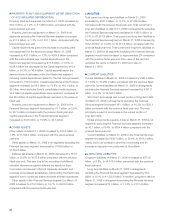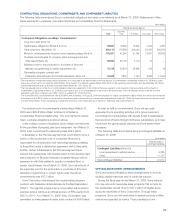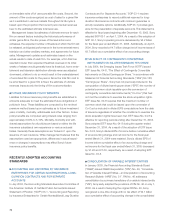Sony 2006 Annual Report Download - page 72
Download and view the complete annual report
Please find page 72 of the 2006 Sony annual report below. You can navigate through the pages in the report by either clicking on the pages listed below, or by using the keyword search tool below to find specific information within the annual report.70
geographical areas due to restrictions on capital transactions.
In order to pursue more efficient cash management, Sony
manages uneven cash distribution among its subsidiaries
directly or indirectly through SGTS so that Sony can reduce
unnecessary cash and cash equivalents as well as borrowings
as much as possible.
The above description covers liquidity and capital resources
for consolidated Sony excluding the Financial Services segment
which secure liquidity on their own.
FINANCIAL SERVICES SEGMENT
In the Financial Services segment, the management of SFH,
Sony Life, Sony Assurance and Sony Bank recognize the
importance of securing sufficient liquidity to cover the payment
obligations that they take on as a result of their ordinary course
of business, and these companies abide by the regulations
imposed by regulatory authorities and establish and operate
under company guidelines that comply with these regulations.
Their purpose in doing so is to maintain sufficient cash and cash
equivalents and secure sufficient means to pay their obligations.
For instance, Sony Life’s cash inflows come mainly from policy-
holders’ insurance premiums and Sony Life keeps sufficient
liquidity in the form of investments primarily in various securities.
Sony Bank, on the other hand, uses its cash inflows, which
come mainly from customers’ deposits in local or foreign
currencies, in order to offer mortgage loans to individuals or to
make bond investments, and establish a necessary level of
liquidity for the smooth settlement of transactions.
Sony Life currently obtains ratings from five rating agencies:
A+ by S&P for long-term counterparty and insurer financial
strength rating, Aa3 by Moody’s for insurance financial strength
rating, A+ by AM Best Company Inc. for financial strength rating,
and AA by R&I for insurance claims paying ability and AA by the
Japan Credit Rating Agency Ltd for ability to pay insurance
claims. Sony Bank obtained an A-/A-2 rating from S&P for its
long-term/short-term local/foreign currency issuer ratings.
RESEARCH AND DEVELOPMENT
In its mid-term corporate strategy announced on September 22,
2005, Sony stressed that the most pressing issue confronting the
company today is the revitalization of its electronics business. The
strengthening of the competitiveness of Sony’s technologies and
its products is an important element of both the revitalization of
the Electronics business and the company’s growth strategy,
and Sony considers research and development activities that
support this competitiveness will remain pivotal to the
company’s mid- to long-term strategy.
Research and Development is focused in three key domains:
a common development platform technology for home and
mobile electronics; semiconductor and device technology
essential for product differentiation and for creating added-value
to products; and software technology.
Reflecting Sony’s mid-term corporate strategy, in October 2005,
the company established the Display Device Development
Group, to accelerate the development of organic light-emitting
diode (OLED) displays, and the Technology Development Group,
to strengthen software development.
Moreover, Sony continues to strengthen the fundamental
research and development structure at three of its corporate
laboratories, Information Technology Laboratories (communication
and security technologies), Material Laboratories (material and
device technologies) and A3 Laboratories (signal processing
technologies).
Research and development costs for the fiscal year ended
March 31, 2006 increased ¥29.8 billion, or 5.9%, to ¥531.8
billion, compared with the previous fiscal year. The ratio of
research and development costs to net sales (which excludes
Financial service revenue and other operating revenue)
increased from 7.6% to 7.9%. The bulk of research and
development costs were incurred in the Electronics and Game
segments. Expenses in the Electronics segment decreased
¥15.2 billion, or 3.5%, to ¥418.1 billion, whereas expenses in
the Game segment increased ¥40.2 billion, or 58.7%, to ¥108.7
billion. In the Electronics segment, approximately 64% of
expenses were for the development of new product prototypes
while the remaining 36% were for the development of mid- to
long-term new technologies in such areas as semiconductors,
communications, displays and next generation optical discs. In
addition, within the Game segment, there was an increase
primarily of hardware-related research and development costs
associated with PS3.
DIVIDEND POLICY
Sony believes that continuously increasing corporate value and
providing dividends are essential to rewarding shareholders. It
is Sony’s policy to utilize retained earnings, after ensuring the
perpetuation of stable dividends, to carry out various invest-
ments that contribute to an increase in corporate value such as
those investments that ensure future growth and strengthen
competitiveness.
A fiscal year-end cash dividend of ¥12.5 per share of Sony
Corporation Common Stock was approved at the Board of
Directors meeting held on May 17, 2006 and was paid on June 1,
2006. Sony Corporation has already paid an interim dividend
























